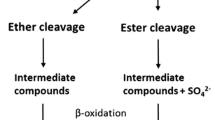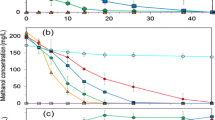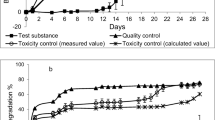Abstract
Chlorella fusca can utilize the following substances as sole sulfur sources for growth: C1 to C8 n-alkane-1-sulfonates, linear alkylbenzenes sulfonates (LAS), α-sulfonated fatty acid esters, polyethylene glycol sulfate and alkylsulfates. Good sulfur sources are alkylsulfonic acids, which are comparable to sulfate. Ethanesulfonic acid was used for comparison of the growth on sulfate and on a sulfonic acid, because best growth was achieved on this C2-sulfonic acid.
Growth data of Chlorella on the enviromental important detergents linear alkylbenzene sulfonic acids, α-sulfonated fatty acid methylester, Texapon and Sulfopon are presented. So far only microorganisms have been discussed as a source for degradation of sulfonic acids and detergents. It is suggested that green algae could be of similar importance for the biodegradation of these compounds.
Similar content being viewed by others
Abbreviations
- LAS:
-
Linear alkylbenzene sulfonate
- ES:
-
α-sulfonated fatty acid methylester
- DTE:
-
dithiocrythritol
References
Anderson R, Kates M, Volcani RL (1978) Identification of the sulfolipids in the non-photosynthetic diatom Nitschia alba. Biochim Biophys Acta 528:89–109
Arnon DI (1949) Copper enzymes in isolated chloroplasts. Polyphenoloxidase in Beta vulgaris. Plant Physiol 24:1–15
Banwart WL, Bremner JM (1975) Formation of volatile sulfur compounds by microbial decomposition of sulfur-containing amino acids in soils. Soil Biol Biochem 7:359–364
Billheimer EC, Reid EE (1930) The decomposition of mercaptans in alkali solutions. J Am Chem Soc 52:4338–4344
Bonsen PPM, Spudich JA, Nelson DL, Kornberg A (1969) Biochemical studies of bacterial sporulation and germination. XII. A sulfonic acid as a major sulfur compound of Bacillus subtilis spores. J Bacteriol 98:62–68
Bradford M (1976) A rapid and sensitive method for the quantitation of microgramm quantities of protein utilizing the principles of protein dye binding. Anal Biochem 72:248–254
Busby WF (1966) Sulfopropanediol and cysteinolic acid in the diatom. Biochim Biophys Acta 121:160–161
Cain RB, Farr DR (1968) Metabolism of arylsulfonates by microorganism. Biochem J 106:859–877
Cook AM, Hütter R (1982) Ametryne and prometryne as sulfur sources for bacteria. Appl Environ Microbiol 43:781–786
Daughton CG, Cook AM, Alexander M (1979) Biodegradation of phosphonate toxicants yields methane or ethane on cleavage the C−P bond. FEMS Microbiol Lett 5:91–93
Endo K, Kondo H, Ishimoto M (1977) Degradation of benzene sulfonate to sulfite in bacterial extracts. J Biochem 82:1397–1402
Godchaux III W, Leadbetter EL (1980) Capnocytophage spp. contain sulfonolipids that are novel in procaryotes. J Bacteriol 44:592–602
Harwood JL, Nicholls RG (1979) The plant sulfolipid — a major component of the sulfur cycle. Biochem Rev 7:440–447
Hatakeyama S, Okuda M, Akimoto H (1982) Formation of sulfur dioxide and methanesulfonic acid in the photooxidation of dimethyl sulfide in the air. Geophys Res Lett 9:583–586
Henkel K (1976) Waschmittelchemie. Dr. A. Hütig Verlag, Heidelberg
Janicke W, Niemitz W (1973) Vergleichende Versuche mit Waschrohstoff und konfektioniertem Waschmittel bei der biologischen Abwasserbehandlung. Vom Wasser 40:369–389
Johnston JB, Murray K, Cain RB (1975) Microbial metabolism of aryl sulfonates. A re-assessment of colorimetric methods for the determination of sulfite and their use in measuring desulfonation or aryl and alkylbenzene sulfonates. J Microbiol Serol 41:493–511
Jüttner F, Wiedemann E, Wurster K (1982) Excretion of S- and O-methylesters and other volatile compounds by Ochromonas danica. Phytochem 21:2185–2188
Kadota H, Ishida Y (1972) Production of volatile sulfur compounds by microorganism. Ann Rev Microbiol 26:127–138
Kharasch N, Arora AS (1976) Chemistry of biologically active sulfur compounds. Phosphorus and Sulfur 2:1–50
Kondo H, Ishimoto M (1972) Enzymatic formation of sulfite and acetate from sulfoacetaldehyde, a degradation product of taurine. J Biochem 72:487–489
Kondo H, Ishimoto M (1975) Purification and properties of sulfoacetaldehyde sulfo-lyase, a thiamine pyrophosphate-dependent enzyme forming sulfite and acetate. J Biochem 78:317–325
Larson RJ, Pane AG (1981) Fate of the benzene ring of linear alkylbenzene sulfonate in natural waters. Appl Envir Microbiol 41:621–627
Laycock MV, McInnes, Morgan KC (1979) d-Homocysteic acid from Palmaria palmata. Phytochem 18:1220
Leidner H, Gloor R, Wüest D, Wuhrmann K (1980) The influence of the sulfonic group on the biodegradability of n-alkylbenzene sulfonates. Xenobiotica 10:47–56
Ninnemann H, Jüttner F (1981) Volatile substances from tissue cultures of potato, tomato and their somatic fusion products. Comparison of gas chromatographic patterns for identification of hybrids. Z Pflanzenphysiol 103:95–101
Organikum (1974) Organisch-chemisches Grundpraktikum, 13. Aufl. VEB Deutscher Verlag der Wissenschaften, Berlin
Panter R, Penzhorn RD (1980) Alkyl sulfonic acids in the atmosphere. Atmospheric Environment 14:149–151
Payne WJ, Feisal VE (1963) Bacterial utilization of dodecyl sulfate and dodecyl benzene sulfonate. Appl Microbiol 11:339–344
Plennart W, Heine W (1973) Normalwerte, 4. Aufl. VEB Verlag Volk und Gesundheit, Berlin
Rhodes D, Stewart GR (1974) A procedure for the in vivo determination of enzyme activity in higher plant tissue. Planta (Berlin) 118:133–144
Ripin MJ, Noon KF, Cook TM (1971) Bacterial metabolism of arylsulfonates. 1. Benzene sulfonate as growth substrate for Pseudomonas testosteroni H-8. Appl Microbiol 21:495–499
Schmidt A (1972) Über Teilreaktionen der photosynthetischen Sulfatreduktion in zellfreien Systemen aus Spinat-chloroplasten und Chlorella. Z Naturforsch 27b:183–192
Schmidt A (1975) Distribution of APS sulfototransferase activity among higher plants. Plant Sci Lett 5:407–415
Schmidt A (1977) Exchange of cysteine-bound sulfide with free sulfide and cysteine synthetase activity in Chlorella pyrenoidosa. Z Pflanzenphysiol 84:435–446
Schmidt A, Erdle I (1983) A cysteine desulfhydrase specific for d-cysteine in the green alga Chlorella fusca. Z Naturforsch 38c:428–435
Shibuya J, Yagi T, Benson AA (1963) Sulfonic acids in algae. In: Studies on microalgae and photosynthetic bacteria. Special issue of Plant and Cell Physiology, Japanese Society of Plant Physiologists (ed). The University of Tokyo Press, pp 627–636
Shimamoto G, Berk RS (1980a) Taurine catabolism. II. Biochemical and genetic evidence for sulfoacetaldehyde sulfo-lyase involvement. Biochim Biophys Acta 632:121–130
Shimamoto G, Berk RS (1980b) Taurine catabolism. III. Evidence for the participation of the glyoxylate cycle. Biochim Biophys Acta 632:399–407
Siegel LM (1965) A direct microdetermination for sulfide. Anal Biochem 11:126–132
Sörbo BH (1955) Rhodanese. In: Colowick S, Kaplan N (eds) Methods in enzymology, vol II. Academic Press, New York, pp 334–337
Stapley EO, Starkey RL (1970) Decomposition of cysteic acid and taurine by soil micro-organism. J Gen Microbiol 64:77–84
Stein W, Baumann H (1975) α-Sulfonated fatty acids and esters: Manufacturing process, properties and applications. J Am Oil Chem Soc 52:323–329
Sullivan WT, Swisher RD (1969) MBAS and LAS surfactants in the Illinois River 1968. Envir Sci Technol 3:481–483
Taylor CD, Wolfe RS (1974) Structure and methylation of coenzyme M (SH−CH2−CH2−SO3). J Biol Chem 249:4879–4885
Thysse GJE, Wanders TH (1972) Degradation of n-alkane-1-sulfonates by Pseudomonas. J Microbiol Serol 38:53–63
Thysse GJE, Wanders TH (1974) Initialsteps in the degradation of n-alkane-1-sulfonates by Pseudomonas. J Microbiol Serol 40:25–37
Wagner FC, Reid EE (1931) The stability of the carbon-sulfur bond in some aliphatic sulfonic acids. J Am Chem Soc 53:3407–3413
Wickberg JW (1957) Isolation of 2-l-amino-3-hydroxi-1-propane sulfonic acid from Polysiphonia fastigiata. Acta Chem Scand 11:506–511
Willetts AJ, Cain RB (1972) Microbial metabolism of alkylbenzene sulfonates. Bacterial metabolism of undecylbenzene-p-sulfonate and dodecylbenzene-p-sulfonate. Biochem J 129:389–402
Willetts AJ (1973) Microbial metabolism of alkylbenzene sulfonates. Fungal metabolism of 1-phenylundecane-p-sulfonate and 1-phenyldodecane-p-sulfonate. J Microbiol Serol 39:585–597
Author information
Authors and Affiliations
Rights and permissions
About this article
Cite this article
Biedlingmaier, S., Schmidt, A. Alkylsulfonic acids and some S-containing detergents as sulfur sources for growth of Chlorella fusca . Arch. Microbiol. 136, 124–130 (1983). https://doi.org/10.1007/BF00404786
Received:
Accepted:
Issue Date:
DOI: https://doi.org/10.1007/BF00404786




